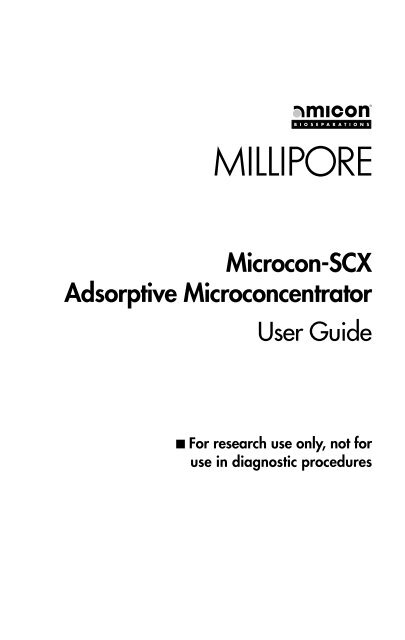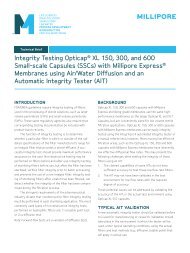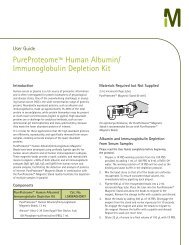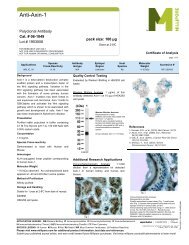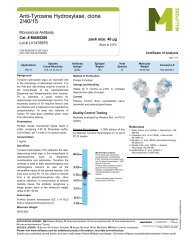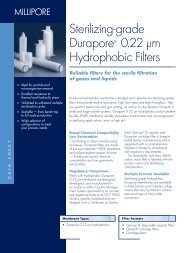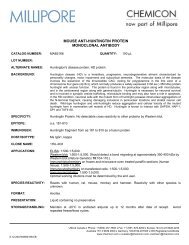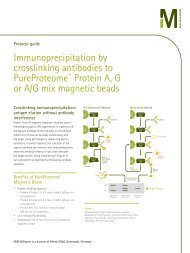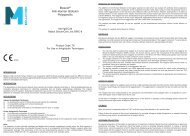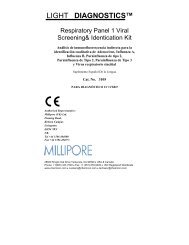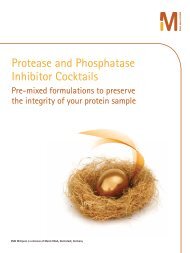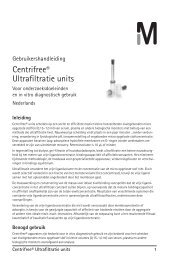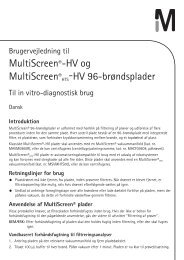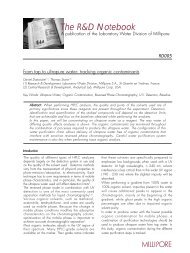Microcon-SCX Adsorptive Microconcentrator - Millipore
Microcon-SCX Adsorptive Microconcentrator - Millipore
Microcon-SCX Adsorptive Microconcentrator - Millipore
Create successful ePaper yourself
Turn your PDF publications into a flip-book with our unique Google optimized e-Paper software.
B I O S E P A R A T I O N S<br />
<strong>Microcon</strong>-<strong>SCX</strong><br />
<strong>Adsorptive</strong> <strong>Microcon</strong>centrator<br />
User Guide<br />
■ For research use only, not for<br />
use in diagnostic procedures<br />
®
B I O S E P A R A T I O N S<br />
<strong>Microcon</strong>-<strong>SCX</strong><br />
<strong>Adsorptive</strong> <strong>Microcon</strong>centrator<br />
User Guide<br />
■ For research use only, not for<br />
use in diagnostic procedures<br />
99452, Rev. D, 06/00<br />
®
Notice<br />
The information in this document is subject to change without notice and should<br />
not be construed as a commitment by <strong>Millipore</strong> Corporation. <strong>Millipore</strong> Corporation<br />
assumes no responsibility for any errors that may appear in this document.<br />
This manual is believed to be complete and accurate at the time of publication. In<br />
no event shall <strong>Millipore</strong> Corporation be liable for incidental or consequential<br />
damages in connection with or arising from the use of this manual.<br />
© 1997, 1998, 2000 MILLIPORE CORPORATION. PRINTED IN THE UNITED<br />
STATES OF AMERICA. ALL RIGHTS RESERVED. THIS BOOK OR PARTS THEREOF<br />
MAY NOT BE REPRODUCED IN ANY FORM WITHOUT THE WRITTEN PERMIS-<br />
SION OF THE PUBLISHERS.<br />
<strong>Millipore</strong> is a registered trademark of <strong>Millipore</strong> Corporation or an affiliated company.<br />
Amicon is a registered trademark of <strong>Millipore</strong> Corporation or an affiliated company.<br />
<strong>Microcon</strong> is a registered trademark of <strong>Millipore</strong> Corporation or an affiliated company.
MICROCON ®<br />
-<strong>SCX</strong><br />
<strong>Adsorptive</strong> <strong>Microcon</strong>centrator<br />
<strong>Microcon</strong>-<strong>SCX</strong><br />
<strong>Adsorptive</strong> <strong>Microcon</strong>centrator<br />
Introduction<br />
<strong>Microcon</strong>-<strong>SCX</strong> is ideal for concentrating peptides or oligonucleotides<br />
and for removing low-molecular-weight contaminants from<br />
samples before other analytical techniques; i.e., mass spectroscopy,<br />
sequencing, amino acid analysis, HPLC and carbohydrate<br />
analysis. This device contains a strong cation exchange membrane<br />
which adsorbs virtually all amino acids, peptides or oligonucleotides.<br />
Due to fast kinetics, high extraction efficiency is achieved<br />
with short spin times. Recommended capacity for peptides is 2–<br />
400 µg/device, depending on sample and rotor type (fixed-angle<br />
centrifuge rotors offer less capacity than horizontal rotors).<br />
NOTE: <strong>Microcon</strong>-<strong>SCX</strong> is intended for concentrating and purifying<br />
amino acids, peptides and oligonucleotides only. The<br />
protocols in this instruction are not recommended for<br />
macromolecules larger than 10,000 MW.
2<br />
http://www.millipore.com<br />
Materials Supplied<br />
Three vials with attached sealing caps are included for each<br />
<strong>Microcon</strong>-<strong>SCX</strong> unit. The product selection guide under “Ordering<br />
Information” provides product numbers for various package sizes.<br />
Equipment Required<br />
Centrifuge that can accommodate 1.5 ml microcentrifuge tubes.<br />
Reagents ¹<br />
Methanol<br />
Deionized water (DIW)<br />
Glacial acetic acid<br />
Ammonium hydroxide (NH4OH)<br />
Hydrochloric acid (HCl)<br />
Desorption reagents² are application-dependent. Make fresh<br />
daily:<br />
1.4 N NH4OH/MeOH (500 µl methanol, 100 µl NH4OH, 400 µl<br />
DIW)<br />
1.2 N HCl/MeOH (500 µl methanol, 100 µl HCl, 400 µl DIW)<br />
¹Reagents are application-specific. This is a standard protocol for sample clean-up of<br />
peptides; see sample elution protocols on page 4 for specific applications.<br />
²Use acetonitrile or isopropanol for peptides that elute from C18 columns above 50% ACN.
<strong>Microcon</strong>-<strong>SCX</strong> <strong>Adsorptive</strong> <strong>Microcon</strong>centrator User Guide<br />
Protocol<br />
For highest sample recovery or concentration, device orientation<br />
in a fixed-angle rotor must remain consistent with each subsequent<br />
centrifugation. Use reservoir’s “mold dimple” as a reference<br />
point to ensure consistent device orientation.<br />
Preparation for Sample Binding<br />
1. Locate “mold dimple” on brown reservoir and insert into vial,<br />
aligning dimple with cap strap as shown.<br />
Align the dimple<br />
with strap on vial cap.<br />
When placing assembled device into centrifuge rotor, always<br />
place cap strap toward center of rotor. Consistent orientation<br />
will ensure maximum sample recovery.<br />
2. Wet membrane by adding 100–200 µl of methanol to device;<br />
agitate briefly then empty methanol to waste. Repeat procedure<br />
with DIW.<br />
NOTE: When performing high-sensitivity analyses (such as<br />
HPLC), centrifuge (at 7,000 × g) 500 µl of methanol<br />
through device for 15 seconds, then 500 µl of DIW.<br />
This will remove interfering substances which elute at<br />
25–30% acetonitrile during reverse-phase HPLC.<br />
3
4<br />
http://www.millipore.com<br />
Preparation for Sample Binding, Continued<br />
3. Remove and empty vial. Place a clean vial on <strong>Microcon</strong>-<strong>SCX</strong><br />
unit in preparation for sample binding. Save the used (empty)<br />
vial if you choose to do a wash step after binding and before<br />
elution of the sample.<br />
Binding Procedure<br />
1. Samples must contain < 0.1 M salt (if necessary, dilute<br />
sample). If the sample volume is greater than 500 µl after<br />
dilution, perform multiple bindings in one <strong>Microcon</strong>-<strong>SCX</strong> unit,<br />
using up to 500 µl of sample per spin.<br />
2. For maximum binding, samples must have a pH below the pI<br />
or pKa of the analyte. If necessary, add 5–10 µl of glacial<br />
acetic acid per 500 µl of sample before binding.<br />
3. Load sample into <strong>Microcon</strong>-<strong>SCX</strong> (a clean vial should be placed<br />
on unit after membrane washing, per step 3 of preparation<br />
procedure).<br />
4. Centrifuge at 1,200 × g for 1 minute. Be sure to maintain<br />
consistent orientation of device in centrifuge. If recovery is<br />
low, save filtrate for further analysis.<br />
5. A wash step (500 µl of 10 mM HCl in DIW) before elution will<br />
remove residual contaminates. If conducted, use vial from<br />
methanol/DIW wash.<br />
Elution Procedure<br />
1. Place <strong>Microcon</strong>-<strong>SCX</strong> containing bound analyte into clean vial.<br />
Align reservoir’s “mold dimple” with cap strap to ensure<br />
reservoir-vial alignment.<br />
2. Pipette 50 µl of desorption reagent (application-dependent)<br />
into unit and spin at 14,000 × g for 15 seconds. To maximize<br />
yields, add another 50 µl of desorption reagent and spin at<br />
14,000 × g for another 15 seconds. Remember to maintain<br />
original orientation in centrifuge.
<strong>Microcon</strong>-<strong>SCX</strong> <strong>Adsorptive</strong> <strong>Microcon</strong>centrator User Guide<br />
Sample Elution Protocols for Specific Applications<br />
This section lists details on protocols for a variety of applications.<br />
Mass Spectroscopy (MS)<br />
Prepare 1.4 N NH 4 OH/MeOH desorption reagent, then follow<br />
steps 1 and 2 of elution procedure. Eluted sample may be directly<br />
applied to electrospray MS or neutralized with 1.2 N HCl for use<br />
with MALDI and/or LC/MS. Alternatively, desorption can be<br />
performed at low pH (see Sequence Analysis).<br />
NOTE: Additional analyte-bound Na + can be removed from the<br />
adsorbed sample by washing unit with 500 µl of 20 mM<br />
ammonium acetate, pH 6.0.<br />
Sequence Analysis<br />
Prepare 3 N HCl/MeOH desorption reagent, then follow steps 1<br />
and 2 of elution procedure. Eluted sample can be spotted onto<br />
glass fiber filter and sequenced. Higher concentrations of HCl (3–6<br />
N) in desorption reagent with 50% IPA may be necessary to<br />
increase sample recovery.<br />
Amino Acid Analysis<br />
Prepare 1.4 N NH 4 OH/MeOH desorption reagent, then follow<br />
steps 1 and 2 of elution procedure. If derivatizing agent (i.e., PTC)<br />
reacts with free amines, an additional dry down with 500 µl of<br />
DIW is required before hydrolysis to remove residual ammonium<br />
ions. Alternatively, elution can be done with 3–6 N HCl desorption<br />
buffer, then vacuum dried and hydrolyzed.<br />
HPLC Analysis<br />
Prepare 1.4 N NH 4 OH/MeOH desorption reagent, then follow<br />
steps 1 and 2 of elution procedure. After elution, neutralize<br />
eluted sample with dilute HCl (1.2 N HCl in DIW) to maximize<br />
sample recovery. Dilute HCl can be placed in the vial before<br />
elution for immediate neutralization. This is useful for samples<br />
which are unstable at high pH or if multiple units are run simultaneously.<br />
If small volumes are needed for HPLC, the final eluted<br />
sample will require speed vacuum lyophilization to remove ammonium<br />
and methanol. Optimal results with speed vacuum lyophilization<br />
are achieved by concentrating the sample volume to 25<br />
µl and diluting 1:2, before HPLC.<br />
5
6<br />
http://www.millipore.com<br />
Carbohydrate Analysis<br />
Prepare glycoprotein for hydrolysis (2 N TFA at 100°C for 5<br />
hours). Following hydrolysis, dilute sample 1:1 with DIW and<br />
speed vac to dryness. Add 100 µl of 20 mM sodium acetate pH 5.0<br />
to dried samples and check pH with strip so that it is between 4<br />
and 5. If not, adjust pH with 0.1 N NaOH. Transfer hydrolysate<br />
in sodium acetate buffer to <strong>Microcon</strong>-<strong>SCX</strong> in a clean vial, centrifuge<br />
at 5,000 × g for 30 seconds, then increase to 14,000 × g for an<br />
additional 30 seconds. The filtrates, free of amino acids, are ready<br />
for PAD analysis.<br />
NOTE: When adding sodium acetate, be sure pH does not drop to<br />
less than pH 4.0. Below this value, amino sugars will bind to<br />
the membrane, yielding low recoveries. Recommended<br />
controls should include: <strong>Microcon</strong>-<strong>SCX</strong> filtered monosaccharide<br />
standards in buffer (positive) and buffer blank<br />
(negative)
<strong>Microcon</strong>-<strong>SCX</strong> <strong>Adsorptive</strong> <strong>Microcon</strong>centrator User Guide 7<br />
Materials of Construction<br />
Sample reservoir: polycarbonate<br />
Sample vial: polypropylene<br />
Membrane functionality: sulfonated polystyrene divinyl benzene<br />
Storage<br />
Store <strong>Microcon</strong>-<strong>SCX</strong> devices at room temperature.<br />
Specifications<br />
Maximum sample volume: 500 µL<br />
Maximum relative centrifugal force: 14,000 × g<br />
Product Ordering Information<br />
This section lists the catalogue numbers for <strong>Microcon</strong>-<strong>SCX</strong> <strong>Adsorptive</strong><br />
<strong>Microcon</strong>centrators. See the Technical Assistance section<br />
for information about contacting <strong>Millipore</strong>. You can also buy<br />
<strong>Millipore</strong> products on-line at www.millipore.com/purecommerce.<br />
Product Selection Guide<br />
Description<br />
<strong>Microcon</strong>-<strong>SCX</strong><br />
<strong>Adsorptive</strong> <strong>Microcon</strong>centrators<br />
Package<br />
Size<br />
8<br />
24<br />
100<br />
Product<br />
Number<br />
42460<br />
42461<br />
42462
8<br />
http://www.millipore.com<br />
Technical Assistance<br />
For more information, contact the <strong>Millipore</strong> office nearest you. In<br />
the U.S., call 1-800-MILLIPORE (1-800-645-5476). Outside the<br />
U.S., see your <strong>Millipore</strong> laboratory catalogue for the phone<br />
number of the office nearest you. You can reach us by e-mail at<br />
tech_service@millipore.com or visit our web site<br />
(www.millipore.com).<br />
<strong>Millipore</strong> Corporation is pleased to provide internet access to<br />
Material Safety Data Sheets (MSDS) for its products that contain<br />
hazardous materials. To obtain any MSDS documents that may be<br />
associated with this product, go to the MSDS page of our website<br />
(www.millipore.com/msds.nsf/home).<br />
The following is a sample of current <strong>Microcon</strong>-<strong>SCX</strong> publications<br />
from “Creative Solutions.” Once you are in the <strong>Millipore</strong> web site<br />
click on any “Solution” description as seen below for the general<br />
procedure and abbreviated protocol in each case. For detailed<br />
protocols click the word “Protocol” at the end of each “Creative<br />
Solution,” or use the right side of the table below. Although you<br />
can perform some applications with different devices, each protocol<br />
is written specifically for the device described. For complete<br />
product information for each device, see the end of each protocol.<br />
Solution Title Protocol For<br />
Solution07 DNA oligomer concentration<br />
and desalting<br />
<strong>Microcon</strong>-<strong>SCX</strong><br />
Solution10 Glycoprotein hydrolysate<br />
preparation before<br />
carbohydrate analysis<br />
<strong>Microcon</strong>-<strong>SCX</strong><br />
Solution12 Oligonucleotide recovery Micropure & <strong>Microcon</strong><br />
from polyarcrylamide gel and <strong>Microcon</strong>-<strong>SCX</strong><br />
Solution14 Peptide concentration and<br />
desalting<br />
<strong>Microcon</strong>-<strong>SCX</strong><br />
Solution15 Peptide concentration and<br />
desalting<br />
<strong>Microcon</strong>-<strong>SCX</strong><br />
Solution16 Peptide preparation before<br />
sequencing<br />
<strong>Microcon</strong>-<strong>SCX</strong>
<strong>Microcon</strong>-<strong>SCX</strong> <strong>Adsorptive</strong> <strong>Microcon</strong>centrator User Guide<br />
General Limited Warranty<br />
<strong>Millipore</strong> Corporation ("<strong>Millipore</strong>") warrants its products will<br />
meet their applicable published specifications when used in<br />
accordance with their applicable instructions for a period of one<br />
year from shipment of the products. MILLIPORE MAKES NO<br />
OTHER WARRANTY, EXPRESSED OR IMPLIED. THERE IS NO<br />
WARRANTY OF MERCHANTABILITY OR FITNESS FOR A<br />
PARTICULAR PURPOSE. The warranty provided herein and the<br />
data, specifications and descriptions of <strong>Millipore</strong> products appearing<br />
in <strong>Millipore</strong>'s published catalogues and product literature<br />
may not be altered except by express written agreement signed<br />
by an officer of <strong>Millipore</strong>. Representations, oral or written,<br />
which are inconsistent with this warranty or such publications are<br />
not authorized and if given, should not be relied upon.<br />
In the event of a breach of the foregoing warranty, <strong>Millipore</strong>'s<br />
sole obligation shall be to repair or replace, at its option, the<br />
applicable product or part thereof, provided the customer notifies<br />
<strong>Millipore</strong> promptly of any such breach. If after exercising<br />
reasonable efforts, <strong>Millipore</strong> is unable to repair or replace the<br />
product or part, then <strong>Millipore</strong> shall refund to the customer all<br />
monies paid for such applicable product or part. MILLIPORE<br />
SHALL NOT BE LIABLE FOR CONSEQUENTIAL, INCIDENTAL,<br />
SPECIAL OR ANY OTHER INDIRECT DAMAGES RESULTING<br />
FROM ECONOMIC LOSS OR PROPERTY DAMAGE SUSTAINED<br />
BY ANY CUSTOMER FROM THE USE OF ITS PRODUCTS.<br />
9


